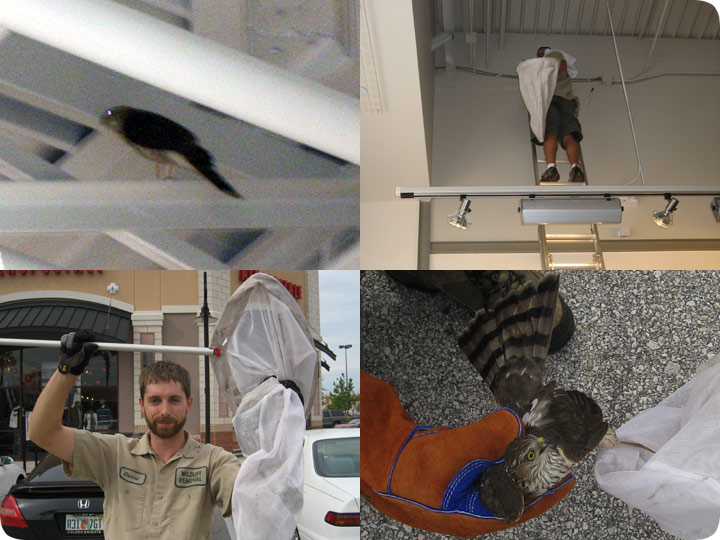-
info@aaanimalcontrol.com
Call us for help in your town
Humane Wildlife Education
Removal of a Hawk From a Retail Store

When I saw it, I identified it as a Cooper's Hawk. It was distressed, as birds stuck in buildings usually are. Since it didn't know how to get out, it continually circled around the rafters, expertly maneuvering between them, and landing on various beams here and there. The ceiling was about 30 feet high. I got a ladder and placed it in the store, near one of the corners that the hawk seemed to prefer to perch on (see upper right).
Usually, the best way to catch a loose bird in a building is to use a mist net. A mist net is composed of very thin material that a bird cannot see, and the bird flies into it and gets stuck, and can then be removed, detangled, and released. However, I didn't have a mist net. I only had small butterfly nets. My only hope was to catch this speed demon on the wing or on the perch. Hawks are fast and alert, and after a while up on the ladder, I realized that the situation was futile. The cautious bird didn't even want to land near me. I got down and grumbled and muttered under my breath, as scads of patrons at the store gawked. I looked up and saw it perching in the preferred spot again, and decided to give it another try. I bent my net so that it fit between the beam and the ceiling, and positioned the net on the beam, facing the wall. By a great stroke of luck, the hawk flew and landed on the beam in between the net and wall. I knew that I had no time - the hawk never stayed perched for more than a second or so - and I swiped the net into the wall at blazing speed. Success! I netted the hawk, just like I've done to thousands of butterflies and moths in my life. I carried it down, took the photo (lower left) in front of the store, and then got my thick gloves and carefully removed the hawk from the net (lower right) and let go, and it flew off to freedom.
Do it yourself: Visit my How To Get Rid of Birds page for tips and advice.
Get professional help: Visit my Nationwide Pro Directory of wildlife removal experts.
For more wildlife stories, click my Wildlife Blog or click my below banner to hire a local trapper.

Hawks are some of the larger birds with majestic features and menacing attributes. These birds feed on smaller birds as well as mammals. Hawks always prefer the outdoors to the indoors. Thus, finding them in a retail store, for example, is an anomaly. A hawk can enter a retail store in search of prey or when being chased after capturing birds like pigeons as prey. If a hawk is being pursued by a group of pigeons after capturing one of them, for example, it can fly low and mistakenly enter a retail store.
A hawk in a retail store is an unusual sight and will cause a variety of reactions. Here are some steps for hawk removal.
Do not panic
The presence of a hawk in a closed space can be a source of panic. It is the natural instinct of birds to fly upwards. Thus, the trapped hawk will think to fly high instead of low to find an exit. Of course, the flying hawk will only compound the panic in the air.
Even though hawks look scary, they are essentially harmless. A hawk will remain harmless unless it feels threatened. To reduce the panic, communicate that the trapped bird is essentially harmless to those in the store at the time.
Find the entrance and leave it open
In a lot of cases, hawks enter retail stores when the doors are left open. If that is the case, leave the door through which the bird came in open so that it can serve as the exit.
After leaving the door open, you can only hope that it flies towards it soon enough and leaves. Since hawks are alert and fast birds and do not like being in an enclosed space, they will leave soon. As soon as the bird makes it exit, be sure to close the door or whatever path it took before a repeat performance occurs.
Use mist nets
Mist nets are tools suited for hawk removal. Mist nets are suitable for removing hawks, and different kinds of birds from buildings. They make great removal tools because the net is usually so thin that the bird doesn’t see it and will fly into it.
To remove a hawk with a mist net, place it in its path and wait for the bird to fly into the net.
When there are no mist nets, butterfly nets can be used. The use of a butterfly net is typically more tasking and will take a longer time, even if done by a professional.
After a hawk is trapped, it should be allowed to regain its freedom outside the store when the entrance has been identified and closed.
Removing hawks from retail stores can be done by oneself or with the help of a professional. When removing the hawk, be sure the take necessary precautions such as wearing thick gloves, especially before releasing the trapped bird. Also, maintain a sense of calmness to hasten the removal.




















